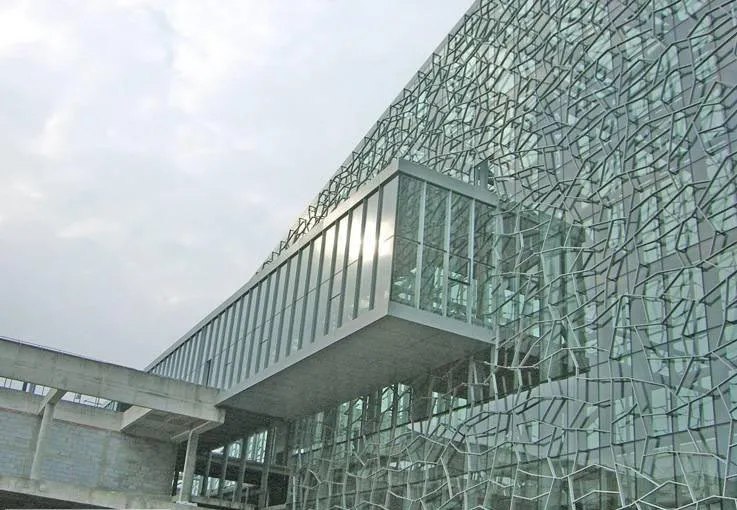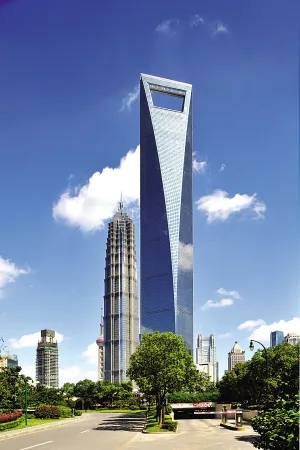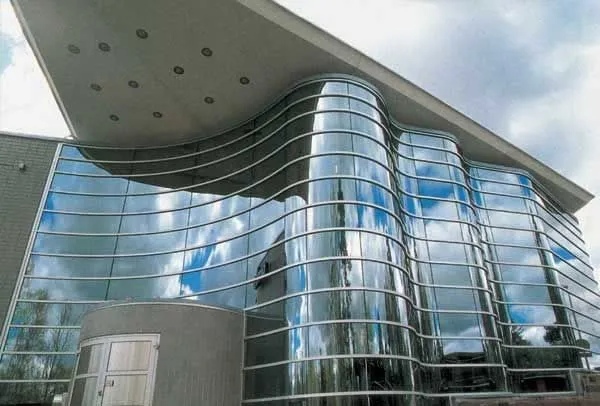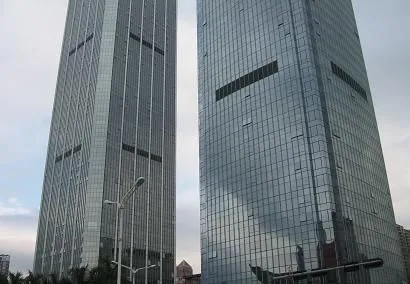
First, the concept of glass curtain wall
Glass curtain wall refers to the composition of a supporting structural system and glass. Relative to the main body, the structure has a certain displacement capacity, and does not share the role of the main structure, the building envelope or decorative structure, because it has the advantages of absorbing infrared rays, reducing the solar radiation entering the room, and reducing the indoor temperature, so it is widely used in China's construction projects. Glass curtain wall is a beautiful and novel method of building wall decoration, which is a prominent feature of the modernist high-rise building era.
In general, the glass curtain wall is a house enclosure wall made of hollow rods rolled by aluminum alloy or other metals as the skeleton and enclosed by glass. There are single and double glazed walls. The reflective insulating glass is 6mm thick, and the wall weight is about 40kg/m², which has the advantages of being light and beautiful, not easy to pollute, and saving energy. The inside of the exterior glass of the curtain wall is coated with a colored metal coating, and the entire façade looks like a mirror from the outside.
2. Architectural background
Nowadays, glass curtain walls have been widely used in high-rise buildings and large public buildings, and under the general trend of saving energy and improving the environment, higher requirements have been put forward for buildings. The application of glass curtain wall not only satisfies the principles of building safety, practicality and beauty, but also brings the building into a new world of heat insulation, sound insulation and green environmental protection. It plays a major role in promoting the development of architecture.
3. The form of glass curtain wall
1. Exposed frame form and grid
"Exposed frame" refers to the glass plate inlaid in the open frame to form an aluminum frame curtain wall component that is exposed on all four sides, and then it is inlaid on the beam column, and the beam column is visible, forming a horizontal and vertical grid.
2. Semi-hidden frame form and lattice line
"Semi-hidden frame" is to embed the two sides of the glass on the aluminum frame, and the other two pairs are pasted on the aluminum frame with structural adhesive, and the exposed beam of the column is blocked and called the mullion horizontally, forming a vertical grid; The exposed columns of the beams are blocked and called the horizontal frame and vertical concealment, forming a horizontal lattice.
3. Hidden frame form and grid
"Hidden frame" refers to the glass is bonded to the aluminum frame with structural adhesive, so that the aluminum frame is hidden behind the glass, forming a large area of all-glass mirror, and the gap between the glass forms a less obvious lattice.
4. Unitized curtain wall
Unitized curtain wall refers to the building curtain wall that is made of various wall rights and supporting frames in the factory and directly installed on the main structure. Unitized curtain wall can be mainly divided into: unitized curtain wall and semi-unit curtain wall, also known as strong unitized curtain wall, semi-unit curtain wall can be divided into detailed and divided into: vertical split unit combined curtain wall, window wall unitized curtain wall.
5. Point-supported curtain wall
Fourth, the advantages of glass curtain wall
Glass curtain wall is a modern new type of wall, which is now widely used in high-rise buildings and some commercial buildings. The biggest feature it gives to the building is the organic combination of architectural aesthetics, architectural function and architectural structure.
The glass curtain walls of modern high-rise buildings are made of a combination of mirrored glass and ordinary glass. Insulating glass is divided into two layers and three layers, and two layers of insulating glass have two layers of glass and a sealing frame to form a sandwich space; Triple glazing is made up of three layers of glass to form two sandwich spaces. Insulating glass has the characteristics of sound insulation, heat insulation, anti-frost, moisture-proof, and strong wind pressure resistance.
1. Light effect
The scenery around the building is refracted and reflected through the glass, forming a rich and wonderful light and shadow effect. The glass curtain wall is made of float glass composition by adding trace elements and tempered into color transparent plate glass. It both reflects light like a mirror and passes through light like glass. The building presents different tones from different angles, and gives people a dynamic beauty with the change of sunlight, moonlight, and lighting.
2. It has the characteristics of absorbing infrared rays
The trace elements added to the glass make the glass have the characteristics of absorbing infrared rays, and can also reduce solar radiation, which is very beneficial to people's health. It also satisfies the safety requirements of the building, so that people can benefit from the building to the greatest extent.
3. Thermal insulation characteristics of insulating glass
It has been measured that when the outdoor temperature is -10°C, the temperature in front of a single-glazed window is -2°C, while the indoor temperature is 13°C when a three-layer insulating glass is used. In summer, double-glazed insulating glass blocks 90% of the sun's radiant heat. Sunlight can still penetrate the glass curtain wall, but most of the sun does not feel hot on the body.
Therefore, the insulating glass curtain wall can play a role in regulating the room temperature, warm in winter and cool in summer, which can effectively save natural resources. The cold air of the air conditioner in summer and the heating air in winter are not easy to lose, and the glass curtain wall partially blocks the transfer of cold and heat, which plays a role in saving resources, effectively reducing greenhouse gas emissions, and controlling the pollution of the atmosphere and the environment. Insulating glass has a wide range of applications in residential, commercial and office buildings, and is a good way to improve the living environment.
4. Sound insulation characteristics of insulating glass
By filling the glass with dry gas, the purpose of blocking the transmission of sound is achieved. This creates a quiet and comfortable environment. It is widely used in residential buildings and office buildings. Because homes require privacy, effective sound insulation can increase privacy and create a calm atmosphere. In the office area, people also need good sound insulation because they need to work carefully and reduce communication. Insulating glass can meet this requirement very well.
Fifth, the shortcomings of glass curtain wall
Glass curtain walls also have some limitations, such as light pollution, high energy consumption and other problems. However, with the continuous emergence of new materials and new technologies, these problems are gradually being incorporated into the comprehensive research system of architectural modeling, building materials and building energy conservation, and are deeply discussed as a whole design problem.
6. The application of glass curtain wall in design
1. Facade composition
The size of the building's floor height, bay and column spacing is uniformly divided according to the size of the building modulus, equal distance and equal height, and the grid line only has two directions, horizontal and vertical, if it is regarded as the bone grid line composed of planes, the glass window panel is the basic shape, and the entire curtain wall façade is like a plane of repeated composition pattern. In order to avoid rigidity and monotony, the design can be changed in the area division of the frame, the color of the glass plate, the adjacent material, and the composition of a new pattern, so as to achieve the perfection of the visual effect, and at the same time to prevent too scattered and trivial.
Glass curtain walls are mostly used in high-rise buildings, and the façade design effect can be achieved through various transformations of glass curtain walls on the surface of the building. The glass curtain wall can show the effect of virtual and real, light and shadow, and façade separation. Glass can also form flat, curved surfaces.

In this building, the glass curtain wall forms a curved surface, which is very fluid and dynamic. The glass curtain wall form of horizontal frame and vertical concealment is adopted to divide the building façade horizontally, so that the glass façade can be extended horizontally and has an aesthetic sense. Such a virtual façade forms a strong contrast with the solid wall at the top and next to it.

The Shanghai World Financial Center, with an inverted trapezoidal shape at the top, is both beautiful and reduces wind pressure. The skyscraper's glass curtain wall reflects the clear blue sky and fluttering white clouds, adding to the brilliant color. The use of glass increases the sense of depth in the space. In the city of high-rise buildings, the skyscrapers rising from the ground make the city become a lot more crowded, and the use of glass curtain walls reflects the space through the glass to form a symmetrical virtual space, which has added a lot of light and space to the city.
2. Color composition

It is possible to intersperse a layer of black glass curtain wall with a white glass curtain wall, which can make this layer of black glass curtain wall more conspicuous. Such a color change can make the building façade less rigid, form a slight color change, and break the overall sense of the façade. Make the building more colorful.
3. Unity of opposites
The glass curtain wall is "virtual", the wall is "real", which can achieve the effect of combining virtual and real, and similarly, different materials bring different virtual and real feelings, and they are combined with each other to achieve the effect of unity of opposites. Blocks, strips, surfaces, and points are interspersed with each other to form a spatial effect of opposition and unity.
The building is a strip building embedded in a block, the strip building is vertically divided, and the block building is in the form of a hidden frame broken glass. The organic combination of the two makes the façade achieve a pattern of opposition and unity.

7. New curtain wall
1. Photoelectric curtain wall
Photoelectric curtain wall, that is, the solar cell is pasted on the glass with special resin, embedded between two pieces of glass, and the light energy can be converted into electricity through the cell. That's it – a solar photovoltaic curtain wall. It uses photocells and photopanels to convert sunlight into electricity, and its key technology is solar photovoltaic cell technology. Solar photocells use the photon energy of sunlight to make the electrons of the irradiated electrolyte or semiconductor material move, thereby generating voltage, which is called the photoelectric effect.
2. Ecological curtain wall
Name: Litong Glass
Mobile:+86 16632961602
Tel:+86 16632961602
Email:vip@litongglass.com
Add:Shahe city,Hebei,China